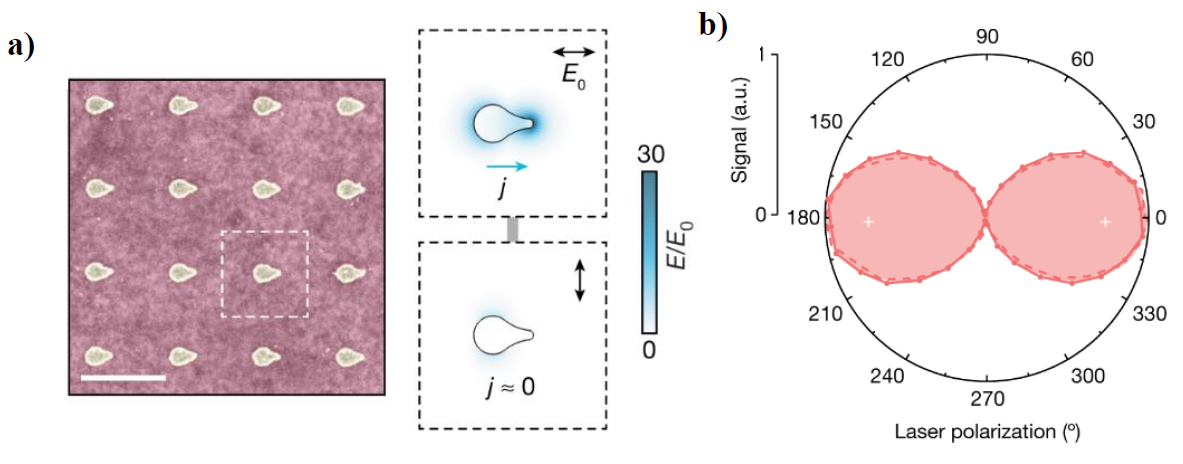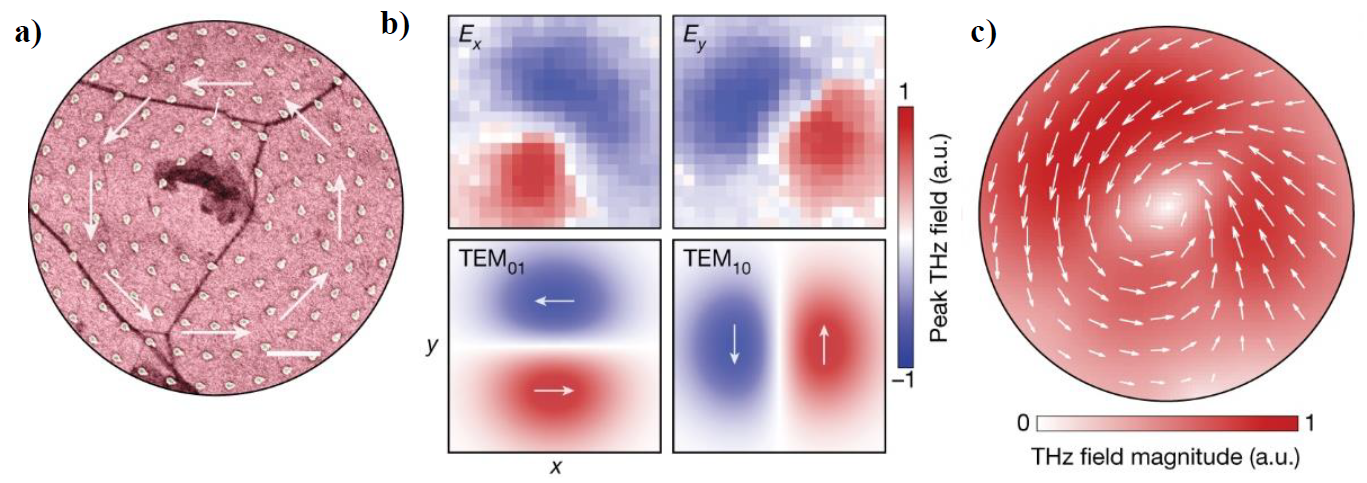| PREVIOUS PRESENTATION | BACK TO PROGRAM OVERVIEW | NEXT PRESENTATION |
Vectorial nanostructured currents and broadband THz vector beams from optoelectronic metasurfaces
Lauren Gingras1, Jacob Pettine2, Ronald Holzwarth1 and Hou-Tong Chen2
1Menlo Systems GmbH. Martinsried, 82152 Germany
2Center for Integrated Nanotechnologies, Los Alamos National Laboratory, Los Alamos, NM, 87545 USA
Our understanding of current control, although crucial for numerous scientific breakthroughs and technological leaps, faces significant challenges at the frontiers of miniaturization and ultrafast dynamics – namely, the nanoscale and femtosecond regimes. Here, we present a novel class of optoelectronic metasurfaces possessing a mechanism where localized, directional charge flows are induced by gold nanoantennas into an underlying graphene layer. These effects culminate in measurable millimeter-scale currents, as evidenced by the broadband patterned terahertz (THz) vector field emission [1] imaged in the far field. Precisely controlling the patterns of terahertz (THz) currents and the light they emit across space still remains a significant challenge. While promising ideas have emerged from other fields, such as using patterned resonator metasurfaces, which showed success in generating tailored THz radiation [2], few have enabled a truly arbitrary control of ultrafast currents leading to broadband patterned THz emission [3-5]. We introduce a new type of surface that combines sub-wavelength-scale nanoplasmonic structures with optoelectronic properties of 2D materials. This enables control over electrical currents triggered by pulsed light and the over the THz light these emit, with precise tailoring over spatial polarization distribution. This opens doors for various applications, including light detection, manipulating magnetism at the nanoscale, and information processing.

Figure 1: SEM images of a uniformly oriented (a) metasurface resonant at 800 nm; scale bars, 500 nm. Insets: simulated resonant plasmonic-field enhancements for parallel and perpendicular incident linear polarization angles (black double arrows), with the calculated net current direction (blue single arrows). (b) Measured x (red) and y (blue, net = 0) components of the radiated THz field (solid lines with data markers) and photocurrent (dashed lines) for the metasurface with respect to the incident linear polarization angle. Calculated linear responses (solid fills) are shown for comparison, with + and − signs indicating lobe polarity. Reproduced from [1] with the authors’ permission.
Figure 1 a) showcases SEM images of optoelectronic metasurface (left side) alongside the associated simulated plasmonic field enhancement (plotted in blue, right insets). The metasurfaces consist of tear-dropped gold nanostructures arranged on monoatomic graphene, deposited on an inert quartz substrate. A femtosecond laser centered at 800 nm excites the gold nanoantennas resonantly to drive a net non-zero current enabled by the symmetry-breaking of the individual nanoantennas. The underlying graphene acts as the channel for the ultrafast current without the need for an external bias voltage. The particular structures showed in Fig. 1a) is arranged in a linear array and emits a linearly polarized beam, with preferential alignment of the polarization parallel to the lattice, as showed in Fig. 1b). The insets in Fig. 1 a) show the simulated plasmonic field enhancement factor (E/E0) for an exciting field polarization parallel and perpendicular to the elongated nanoantenna axis. The sample configuration is elegantly simple and reaches up to 4 THz in emitted bandwidth and a generation efficiency comparable to that of a 1 mm-thick ZnTe crystal (not shown here), greatly improving on current schemes which generally rely on bulky multi-stage solutions or which only produce narrowband patterned THz light [6].
The current generated by the nanoantenna can also be engineered to create complex patterns of current flow, even at the nanoscale. To see this effect on a larger scale, azimuthal patterns were engineered and resulting polarization pattern of the terahertz (THz) light emitted were measured. SEM images of the sample are shown in Fig. 2 a) where the gold nanoantennas can be seen arranged in a circular fashion and where in the experiment, the entire sample (1 mm in diameter) is uniformly excited by femtosecond NIR pulsed. As expected, the measured electric field distribution data at the peak-THz time-slice shows a flip in polarization when observing opposite sides of the beam (Fig. 2 b), along with a dark region in the center where the currents cancel each other out. The experimentally measured polarization-sensitive maps (upper panels) are in good agreement with expected ideal Hermite–Gaussian modes (lower panels) for both polarization stages (Ex and Ey). Minor discrepancies are attributed to slight misalignment of the sample and imaging optics. When combined and overlayed, the x- and y-polarization maps show the recorded azimuthal vector field (Fig. 3.c) again with a dark region at the center where the currents cancel out, as predicted by the sample design. The overlayed arrows show the amplitude of the local generated electric field.

Figure 2: (a) SEM image of the central region of a azimuthal vector metasurface, with arrows illustrating the expected radial photocurrent on circularly polarized excitation. Scale bar, 1 μm. (b) Measured (top) versus ideal (bottom) Hermite–Gaussian modes for the x and y field components of the radial THz vector beam. Arrows in the bottom plots indicate the THz field polarity at peak E-field time-slice. (c) Far-field spatial map of the radial THz vector field, showing the total measured THz field magnitude (colour map and length of white arrows) and direction (direction of white arrows) at the pulse peak. Reproduced from [1] with the authors’ permission.
The far field images were recorded using a fiber-coupled antenna detector mounted on imaging stages scanning across the beam powered by a commercial THz spectrometer from Menlo Systems. A common 100 MHz erbium-doped fiber oscillator seeds a pump arm and a detection arm containing a 1560 nm amplifier and fiber-coupled photoconductive antenna. The pump arm features a newly developed linear amplifier with 100 fs pulses at 780 nm producing 1 mW of average power to illuminate the samples, also at a 100 MHz repetition rate. The samples are illuminated with circularly polarized light in order to resonantly excite all possible orientations of the nanoantenna array.
The observation of the Hermite-Gaussian modes confirmed the presence of the vector currents generated. This not only proves the existence of these complex current patterns but also demonstrates a new method for directly creating specific types of terahertz light waves. This new approach unlocks exciting possibilities for exploring and understanding the unique properties of terahertz light (THz). It allows the investigation of a much wider range of factors that influence THz physics such as control experiments requiring illumination with ultrafast pulses with exotic polarization states.
References
[1] Pettine, J., Padmanabhan, P., Shi, T., Gingras, L. et al. “Light-driven nanoscale vectorial currents,” Nature 626, 984–989 (2024)
[2] S. Keren-Zur, M. Tal, S. Fleischer, D. M. Mittleman, and T. Ellenbogen, “Generation of spatiotemporally tailored terahertz wavepackets by nonlinear metasurfaces,” Nature Comm. 10, 1778, (2019)
[3] Zeng, J., Wang, X., Sun, J. et al. “Manipulating Complex Light with Metamaterials,” Sci Rep 3, 2826 (2013)
[4] Sato, M., Higuchi, T., Kanda, N. et al. “Terahertz polarization pulse shaping with arbitrary field control,” Nature Photon 7, 724–731 (2013)
[5] Ryo Imai, Natsuki Kanda, Takuya Higuchi, Kuniaki Konishi, and Makoto Kuwata-Gonokami, “Generation of broadband terahertz vortex beams,” Opt. Lett. 39, 3714-3717 (2014)
[6] Petrov, N. V., Sokolenko, B., Kulya, M. S., Gorodetsky, A. & Chernykh, A. V. “Design of broadband terahertz vector and vortex beams: I. Review of materials and components,” Light Adv. Manuf. 3, 640–652 (2022)
